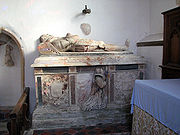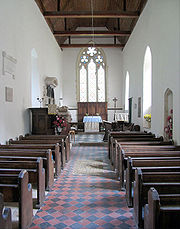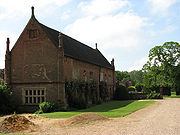
Oxnead
Encyclopedia

Aylsham
Aylsham is a historic market town and civil parish on the River Bure in north Norfolk, England, about north of Norwich. The river rises near Melton Constable, upstream from Aylsham and continues to Great Yarmouth and the North Sea, although it was only made navigable after 1779, allowing grain,...
. It now consists mostly of St Michael’s Church and Oxnead Hall. It was the principal residence of the Paston family from 1597 until the death of William Paston, 2nd Earl of Yarmouth
William Paston, 2nd Earl of Yarmouth
William Paston, 2nd Earl of Yarmouth was a British peer and politician.Born in 1654, he was the son of Robert Paston, 1st Earl of Yarmouth and his wife, Rebecca, née Clayton. In 1671, he married the widowed Charlotte Howard, née FitzRoy , the illegitimate daughter of Charles II and Elizabeth...
in 1732. Under Sir William Paston (1610–1663), Oxnead was the site of several works by the architect and sculptor, Nicholas Stone
Nicholas Stone
Nicholas Stone was an English sculptor and architect. In 1619 he was appointed master-mason to James I, and in 1626 to Charles I....
, master-mason to Kings James I
James I of England
James VI and I was King of Scots as James VI from 24 July 1567 and King of England and Ireland as James I from the union of the English and Scottish crowns on 24 March 1603...
and Charles I
Charles I of England
Charles I was King of England, King of Scotland, and King of Ireland from 27 March 1625 until his execution in 1649. Charles engaged in a struggle for power with the Parliament of England, attempting to obtain royal revenue whilst Parliament sought to curb his Royal prerogative which Charles...
.
Early history
According to Blomefield, the place takes its name from its site on meadows beside a river known to the BritonsBritons (historical)
The Britons were the Celtic people culturally dominating Great Britain from the Iron Age through the Early Middle Ages. They spoke the Insular Celtic language known as British or Brythonic...
and Saxons
Saxons
The Saxons were a confederation of Germanic tribes originating on the North German plain. The Saxons earliest known area of settlement is Northern Albingia, an area approximately that of modern Holstein...
as the Ouse. At the time of the Domesday
Domesday Book
Domesday Book , now held at The National Archives, Kew, Richmond upon Thames in South West London, is the record of the great survey of much of England and parts of Wales completed in 1086...
survey, the estate belonged to Halden and altogether was worth 30 shillings. It was seven furlongs long and six broad and included a church with twenty-four acres of glebe land. At the time of King Stephen, Oxnead belonged to Albert Greslei, from whom it passed to the Hauteyn family. Around 1368, the estate was acquired by Sir Robert de Salle. After Sir Robert’s death, his widow’s second husband, Sir William Clopton, took control of Oxnead and in the 1420s it was sold to William Paston, of Paston
Paston, Norfolk
Paston is a village and civil parish in the English county of Norfolk. The village is north-east of North Walsham and south-east of Cromer. It is north-east of the city of Norwich. The village sits astride the coast road between Mundesley and Bacton. The nearest railway station is at North...
.
Paston Family

Field of the Cloth of Gold
The Field of Cloth of Gold is the name given to a place in Balinghem, between Guînes and Ardres, in France, near Calais. It was the site of a meeting that took place from 7 June to 24 June 1520, between King Henry VIII of England and King Francis I of France. The meeting was arranged to increase...
, bequeathed it to his fourth son, Clement Paston (1515–1597).
Sir Clement Paston (1515–1597) built the Oxnead Hall of which one wing remains today. Blomefield notes that Clement was born at Paston Hall on ‘the sea coast, and having a genius and love for shipping and navigation, was in his youth admitted to the service of King Henry VIII in the navy, and made captain of one of the King's ships’, and in an engagement with the French [in May, 1546, in command of the Anne Gallant, according to the Oxford Dictionary of National Biography] took their admiral called the Baron de St. Blankheare, or Blankard, whom he kept a prisoner at Castor by Yarmouth till he paid 7000 crowns, for his ransom, besides considerable things of value, which were found in his ship’. Blomefield also notes of Clement that ‘King Henry VIII called him his Champion; the Duke of Somerset, Protector in King Edward's reign, called him his Souldier; Queen Mary, her Seaman; and Queen Elizabeth, her Father’.

In his will, Clement desired "his body to be laid in the earth in the chauncel of the parish church of Oxned, his funeral not to be costly, nor over sumptuous, but decent and christian-like, according to his degree and calling; a fair and convenient tomb to be made over his body, and his and his wife's arms to be graven thereon”.
Clement left Oxnead to his nephew, Sir William Paston (1528–1610). This William was the founder of the Paston Grammar School in North Walsham
North Walsham
North Walsham is a market town and civil parish in Norfolk, England in the North Norfolk district.-Demographics:The civil parish has an area of and in the 2001 census had a population of 11,998. For the purposes of local government, the parish falls within the district of North...
. He made Oxnead his principal home but is buried in North Walsham church. His second son, Sir Edmund Paston (1585–1632) inherited the family estates and is buried in Paston church.
Sir William Paston (1610–1663) succeeded Sir Edmund. He studied at Corpus Christi College, Cambridge
Corpus Christi College, Cambridge
Corpus Christi College is a constituent college of the University of Cambridge. It is notable as the only college founded by Cambridge townspeople: it was established in 1352 by the Guilds of Corpus Christi and the Blessed Virgin Mary...
, graduating as a Bachelor of Arts in 1626. Ketton-Cremer comments that in 1632, William inherited what may well have been the richest estate in Norfolk. In 1636, he became High Sheriff of Norfolk, and on June 8, 1642, was created a baronet. His first wife was Lady Katherine Bertie, daughter of the Earl of Lindsey
Earl of Lindsey
Earl of Lindsey is a title in the Peerage of England. It was created in 1626 for the 14th Baron Willoughby de Eresby . He was First Lord of the Admiralty from 1635 to 1636 and also established his claim in right of his mother to the hereditary office of Lord Great Chamberlain of England...
. Lady Katherine died in childbirth in 1636 after seven years of marriage and was buried in the chancel of Oxnead church. Ketton-Cremer describes Sir William as a lover of art and poetry and patron of writers and painters. Among this patronage was Paston’s commissioning of Nicholas Stone
Nicholas Stone
Nicholas Stone was an English sculptor and architect. In 1619 he was appointed master-mason to James I, and in 1626 to Charles I....
to carve memorials to his parents in Paston Church, busts for his house at Oxnead and statuary for his gardens. Sir William died in 1663 and is buried at Paston.
Sir William’s son, Sir Robert (1631–1683) became Baron Paston and Viscount Yarmouth in 1673 and 1st Earl of Yarmouth
Robert Paston, 1st Earl of Yarmouth
Robert Paston, 1st Earl of Yarmouth, FRS was an English politician, nobleman and scientist. The Paston family had a long history. His father William , was created a baronet in 1642, and on his death was succeeded in the title by Robert. Robert was subsequently created a Viscount and then became an...
in 1679. According to the Oxford Dictionary of National Biography, Robert like his father was an avid collector of ‘books, paintings, jewellery and curios’. He also continued to develop Oxnead Hall and built a banqueting hall for the visit of King Charles II in 1671. However, his extravagance caused increasing financial difficulties and he had to mortgage or sell large parts of his estates. He died in 1683 and is buried at Oxnead.

William Paston, 2nd Earl of Yarmouth
William Paston, 2nd Earl of Yarmouth was a British peer and politician.Born in 1654, he was the son of Robert Paston, 1st Earl of Yarmouth and his wife, Rebecca, née Clayton. In 1671, he married the widowed Charlotte Howard, née FitzRoy , the illegitimate daughter of Charles II and Elizabeth...
(1653/4-1732), inherited the title and estates, and married a natural daughter of King Charles II, Lady Charlotte Fitzroy, but continued to run heavily into debt. He was also the last of the male line and with him the titles became extinct. Blomefield comments that ‘after the death of this Earl, who left his estates to pay his debts, this agreeable seat, with the park, gardens, &c. soon run into decay, the greatest part of the house was pulled down, the materials sold, only a part of it left for a farmer to inhabit, and was sold to the Right Honourable Lord Anson.’
St Michael’s Church
The church is mostly thirteenth-century and built of flint with stone dressings. However, there are several later additions in brick, dating from the sixteenth to eighteenth centuries, such as the top of the tower, two porches and a stepped east gable.Inside, there is a monument to Sir Clement Paston (1515–1597). This is a tomb-chest featuring his recumbent effigy and a kneeing figure of his wife, Lady Alice. There is also a monument to Lady Katherine Paston, wife of Sir William (1610–1663), who died in childbirth in 1637. This work is by the celebrated Jacobean sculptor Nicholas Stone
Nicholas Stone
Nicholas Stone was an English sculptor and architect. In 1619 he was appointed master-mason to James I, and in 1626 to Charles I....
. The church also includes a seventeenth century font.
Oxnead Hall

A two-storey service wing, with mullioned and transomed windows, is all that remains of this Hall. Pevsner comments that the west front ‘displays a nice pedimented doorway and a moulded platband between the floors.’ A nineteenth century extension has been added and the Hall is occupied.
Nothing remains of the garden statuary installed by Nicholas Stone, though his Hercules, originally from Oxnead, can be seen in the Orangery at Blickling Hall
Blickling Hall
Blickling Hall is a stately home in the village of Blickling north of Aylsham in Norfolk, England, that has been in the care of the National Trust since 1940.-History:...
. Blickling, in its parterre, also has a sixteenth or early seventeenth century fountain, consisting of a basin on a base, bought from Oxnead in 1732.
Oxnead Mill
Across the River BureRiver Bure
The River Bure is a river in the county of Norfolk, England, most of it in The Broads. The Bure rises near Melton Constable, upstream of Aylsham, which was the original head of navigation. Nowadays, the head of navigation is downstream at Coltishall Bridge...
is Oxnead watermill. This is a four storey edifice dating from 1851. A mill existed in Oxnead at the time of the Domesday survey. From about 1716 to 1822 the site was occupied by a paper mill. The mill then made blankets until being rebuilt in 1851 as a flour mill. In 1940 the mill reverted to paper making.
See also
- Paston, NorfolkPaston, NorfolkPaston is a village and civil parish in the English county of Norfolk. The village is north-east of North Walsham and south-east of Cromer. It is north-east of the city of Norwich. The village sits astride the coast road between Mundesley and Bacton. The nearest railway station is at North...
- Paston LettersPaston LettersThe Paston Letters are a collection of letters and papers from England, consisting of the correspondence of members of the gentry Paston family, and others connected with them, between the years 1422 and 1509, and also including some state papers and other important documents.- History of the...
- Nicholas StoneNicholas StoneNicholas Stone was an English sculptor and architect. In 1619 he was appointed master-mason to James I, and in 1626 to Charles I....
- Musaeum ClausumMusaeum ClausumMusaeum Clausum , also known as Bibliotheca abscondita, is a tract written by Sir Thomas Browne first published posthumously in 1684. The book contains short descriptions of supposed, rumoured or lost books pictures and objects...
- Robert Paston, 1st Earl of YarmouthRobert Paston, 1st Earl of YarmouthRobert Paston, 1st Earl of Yarmouth, FRS was an English politician, nobleman and scientist. The Paston family had a long history. His father William , was created a baronet in 1642, and on his death was succeeded in the title by Robert. Robert was subsequently created a Viscount and then became an...
- William Paston, 2nd Earl of YarmouthWilliam Paston, 2nd Earl of YarmouthWilliam Paston, 2nd Earl of Yarmouth was a British peer and politician.Born in 1654, he was the son of Robert Paston, 1st Earl of Yarmouth and his wife, Rebecca, née Clayton. In 1671, he married the widowed Charlotte Howard, née FitzRoy , the illegitimate daughter of Charles II and Elizabeth...

